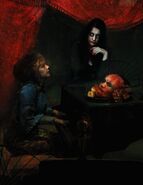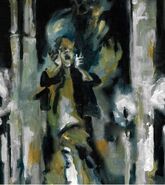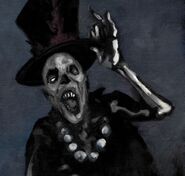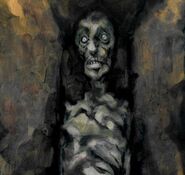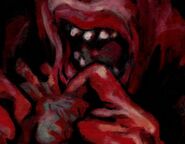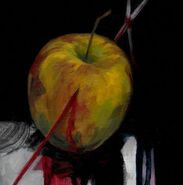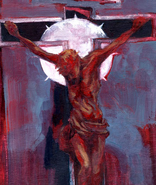The Hecata are the newest vampire clan in the World of Darkness. They are vampires specialized in necromancy.
Overview[]
They are not a fully organic clan deriving from a single Antediluvian and an uninterrupted bloodline, but are made up of the Giovanni and the remnants of the old Clan Cappadocian and their related bloodlines, as well as the Nagaraja, despite a lack of connection with an Antediluvian.[2] Together, they represent a new, (mostly) unified Clan of Death comprising Kindred bloodlines who practice necromancy through the use of Oblivion. Much like the Giovanni that it almost entirely subsumes, it is also a family, albeit a much more extended one.
With the Banu Haqim joining the Camarilla and the Ministry joining the Anarchs, the Hecata are the last independent clan of significance in contemporary nights.
History[]
| “ | We will weather the fires of the Second Inquisition. We come together as the last truly independent clan, because we must. The Feast, The Promise, The Reunion. Death, Rot, Rebirth. The Three Faces. We survived and now we become what we always were. The Hecata. The Clan of Death.” | ” |
| — Amr Salib, Hecata childe of an unknown Cappadocian | ||
The brief history of Clan Hecata is one of necessity as first principle. The Second Inquisition was one associated factor, taking a heavy toll on Clan Giovanni in North America and forcing much of the clan organization there to regroup back in Italy. Another factor was that the Promise of 1528 was rumored to be coming to an end soon after an unspecified 500-year time limit.
Two other significant events occurred at or around this time: first, the death or disappearance of Augustus Giovanni, founder and patriarch of the Giovanni; and a devastating assault by the Harbingers of Skulls on the clan's holdings in Venice, undertaken with the assistance of some younger members of the Giovanni.
Between the damage of the Harbingers' attack and the maelstrom of wraiths unleashed by Augustus's undoing, the Giovanni called for negotiations in a conference that came to be known as the Family Reunion. The Harbingers agreed, and not only did they show up, but also the Samedi, any remaining Cappadocians, the Lamia, and even a handful of Nagaraja seeking refuge from a "catastrophe." The parties negotiated an end to the hostilities, and the clan known as the Hecata soon came into fruition.
After the formation of the Hecata, many sects are in worrying concern about the newly established Clan of Death in the spreading woodworks. Most notably the Camarilla with the Promise of 1528 being something the Inner Circle are at unease with their chances very low to gain some control over. Several, even many, wanting the clan to dissolve in order to lessen their threatening potential.
Weaknesses[]
Banes[]
- Painful Kiss Due to mysterious changes in the Blood, many Hecata no longer have their old curses—the Samedi are no longer rotting corpses, the Nagaraja no longer require the sustenance of flesh, and the Cappadocian and Harbingers of Skull no longer have their corpse-like complexion—instead, many now share the same clan bane: the excruciatingly painful Kiss.
- Variant — Decay: These Hecata are, in a sense, radioactive—not of gamma radation, but of pure entropy. Everything around them seems to suffer decay at a gradual but noticeable pace, including their Havens, their personal Resources, and even their Retainers. The Hecata suffers additional Flaw dots equal to their Bane Severity, divided among Haven, Resources, and Retainer Flaws. This can be substituted with a penalty of buying Background dots at twice the cost at character creation. Further Advantage dot purchases are also penalized by a tax of experience points equal to Bane Severity.
Compulsion[]
Morbidity: a sense of morbid curiosity. The Hecata's Blood urges them to study the individuals around them for signs of illness, frailty, or impending death. Until they have either predicted a death or solved the cause of a local one, the vampire suffers a three-dice penalty to other rolls. Their conclusions do not need to be absolutely correct, but should stay within the boundaries of the possible.
Variant from Vampire: The Masquerade Player's Guide 5th Edition: The vampire experiences an immediate need to move something from life to death or vice-versa. Any action not dedicated to ending or resurrecting something is taken at a two-dice penalty. This subject doesn't have to be a person, or even a living thing, but can include objects or even more abstract things such as a idea or a conversation. The Compulsion lasts until the vampire manages to kill or return something to life (figuratively or literally).
Bloodlines[]
The Hecata are composed of ten main bloodlines:
- La Famiglia Giovanni, or Clan Giovanni as it has been known until recent nights, still largely occupying the overall leadership role in the Hecata, even without Augustus Giovanni as an anchoring influence. They do not normally identify themselves to clan outsiders as Hecata. La Famiglia also includes other satellite families, such as the Della Passaglias and Ghibertis, who have not earned their own individual bloodline status to date.
Optional Discipline spread: Dominate, Fortitude, Oblivion - The Harbingers of Ashur, the aggregate remnants of Clan Cappadocian, of both the mainline clan and the Harbingers of Skulls.
- Nasyon san an (Nation of Blood), the new face of the Samedi bloodline.
Optional Discipline spread: Fortitude, Obfuscate, Oblivion - The Gorgons, the surviving remnants of the Lamia, the Cappadocian bloodline of devout Bahari faith from whom the curse of the painful Kiss originates.
Optional Discipline spread: Fortitude, Potence, Oblivion - The Flesh-Eaters, a group of Nagaraja who showed up to the Family Reunion, seeking refuge from a catastrophe.
Optional Discipline spread: Auspex, Dominate, Oblivion - The Bankers of Dunsirn, the cannibalistic banking family from Scotland, once a branch of Clan Giovanni, and now considered a bloodline in their own right.
Optional Discipline spread: Dominate, Fortitude, Oblivion - The Children of Tenochtitlan, the Giovanni allies Pisanob (now without the leadership of Pochtli), once driven to the brink of extinction by the Harbingers of Skulls.
Optional Discipline spread: Dominate, Fortitude, Oblivion - The Criminal Puttanesca, a Sicilian crime family formerly attached to the Giovanni.
Optional Discipline spread: Dominate, Fortitude, Oblivion - The Little Siblings, are the Rossellini, once a rival necromantic family (now attached) to the Giovanni, they are known for their cruel treatment and exploitation of wraiths.
Optional Discipline spread: Dominate, Fortitude, Oblivion - The Grudge Masters, are the Milliners, a minor Giovanni family with many connections in organized crime.
Optional Discipline spread: Dominate, Fortitude, Oblivion
Trivia[]
- "Hecata", "Hecate" and "Hekate" are alternative forms of the Latin "Hecatae" and Greek "Hekátē" a goddess who was associated with crossroads, entrance-ways, magic, necromancy, night, light, the Moon, witchcraft, the protection from said witchcraft, graves, ghosts, herbs and poisonous plants in the ancient Greek mythology. She would be later syncretised in early forms of Greek Christianity as a Savior (Soteira) and Mother of Angels.
- Hecate is also a Goddess with three faces, one which sees the present, one which sees the future and one which sees the past. Therefore, one could assign each of the main bloodlines to a face: Harbingers, Giovanni and Nagaraja.
Gallery[]
References[]
Books[]
- VTM: Trails of Ash and Bone


- VTM: Children of the Blood


- VTM: Cults of the Blood Gods


- VTM: Chicago by Night 5th Edition, p. 50, 54, 71, 77, 89, 145, 146, 215, 292, 295, 342



- VTM: 5th Edition Corebook, p. 363


- VTM: Camarilla, p. 120


References & Citations[]
- ↑ At the Storyteller's discretion, Giovanni can replace Auspex with Dominate, the Samedi with Obfuscate, and Lamia with Potence. Nagaraja can replace Fortitude with Dominate. Alternatively, the Storyteller may give Hecata players of these bloodlines the option to purchase an exclusive 4-dot Merit to open their respective substitute as an extra in-clan Discipline.
- ↑ The varying Hecata bloodlines are represented by the use of Backgrounds and Loresheets.
| Vampire: The Masquerade Sects | |
|---|---|
| Major
|
Anarch • Ashirra • Camarilla • Sabbat (Black Hand) |
| Minor
|
Inconnu • Independent Clans • Hecata • Tal'Mahe'Ra |
| Other
|
Independent Alliance • Lost Tribe |
| Vampire: The Masquerade Clans |
|---|
| Banu Haqim (Assamites) · Brujah · Gangrel · Hecata (Cappadocians, Giovanni) · Lasombra · Malkavian · Ministry (Followers of Set) · Nosferatu · Ravnos · Salubri · Toreador · Tremere · Tzimisce · Ventrue |






